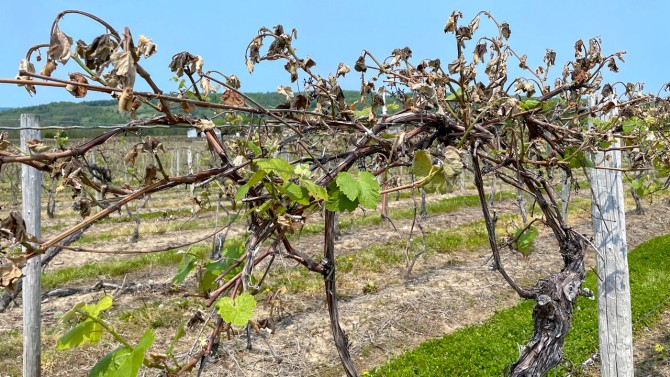
Fred Frank, left, owner of Dr. Konstantin Frank’s Vinifera Wine Cellars; Richard Ball, commissioner of the New York State Department of Agriculture and Markets; and Hans Walter-Peterson, senior viticulture extension specialist, survey vineyard damage along Keuka Lake on May 26.
Spring freeze: Cornell helps vintners recover growing season
By Blaine Friedlander, Cornell Chronicle
In the aftermath of a prolonged mid-May freeze, two Cornell viticulture experts are helping to advise grape growers in New York on how to rescue their season.
Currently, the vineyards now face a possible reduced crop and economic loss.
“It was warm in late April and early May, so we had a wide range of shoot development on the vines,” said Hans Walter-Peterson, a senior viticulture extension specialist and team leader at Cornell Cooperative Extension’s (CCE) Finger Lakes Grape Program, in the College of Agriculture and Life Sciences. “Buds form on the vines and then shoots, and those shoots came out early. Then, we had a prolonged, several-hour freeze event.”
More than 200 grape growers, vintners, local, state and federal officials met May 25 – in an online video conference organized by CCE – to discuss moving forward following the overnight freeze that destroyed the burgeoning grapevine shoots, primarily in the Fingers Lakes and portions of the Hudson Valley region.
In addition to the large meeting, Walter-Peterson, who is also a Cornell doctoral student in horticulture, toured three freeze-damaged Finger Lakes vineyards on May 26 with Richard A. Ball, commissioner of the New York State Department of Agriculture and Markets. Ball was able to see the damage, so that he could advise the governor, state legislators and agricultural groups.
The devastating cold snap occurred May 17-18, when temperatures dropped below freezing from about midnight to dawn in the central Finger Lakes and Hudson Valley wine regions, according to weather data from Cornell’s Northeast Regional Climate Center.
In his assessment of the Finger Lakes, Walter-Peterson said that the Keuka Lake area vineyards were the hardest hit, with steady damage at about 50% of vineyard acreage affected, while Seneca and Cayuga lake vineyards varied in their damage.
From Lake Ontario, which offers a heat buffer, the damage appeared to be heavier going south toward the Finger Lakes, Walter-Peterson said.
Experts are also evaluating damage to other crops from the frost, including apples, blueberries, raspberries and cherries.
In the meeting, Walter-Peterson and officials from the Farm Services Agency, a part of the U.S. Department of Agriculture, said efforts are underway to obtain a federal-disaster designation – but it may be from several months to more than a year away – due to economic fact finding and data collection.
The growers were reminded to document the extent of damage, photograph and map the damaged fields, in case they needed to file crop insurance claims or if the state or federal governments declared a disaster.
Experts also encouraged growers to watch for secondary shoots forming in hybrid grape varieties.
The crop from the secondary shoots will not completely make up for the freeze-damage loss, but it will likely help to recover some portion of it, Walter-Peterson said.
Spring freezes periodically occur, resulting in perhaps a few singed leaves. Generally, the flourishing shoots survive because the freeze is usually a short period of time – such as an hour or two. But Walter-Peterson noted water was abundant in the green tissue of the shoots and in a lengthy freeze, ice forms. “That’s what causes cell death and that’s what causes the shoots to die,” he said.
Grapevine shoots – which contain leaves, curlicue tendrils and tiny fruit – emerge from buds as the spring days warm, said Jason Londo, associate professor in the School of Integrative Plant Science Horticulture at Cornell AgriTech in Geneva. He conducts research on fruit crop stress physiology and adaptation, and grapevine cold hardiness.
“What helps the shoots to grow is swelling, as the water within the cells stretch things out,” Londo said. The current damage appears to be in the early cultivars, he said, as the shoots were further along in development. “When you have that much water in a cell in a cold snap, it’s very hard to keep it from freezing.”
While the last major spring freeze occurred in New York’s Lake Erie grape region in 2012, according to Londo, protecting vineyards from frost remains an active area of research.
“It’s challenging,” Londo said. “There are not a lot of ways to get plants to resist freezing once they have water in those big cells. Frost timing and plant development are both dynamic each year and they don’t always sync up. It’s hard to develop mitigation techniques that work for every freeze.”
Media Contact
Abby Kozlowski
Get Cornell news delivered right to your inbox.
Subscribe


